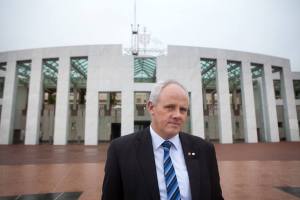[Editor’s note: Senator John Madigan represents Victoria, much of which is rural farm land and bush country to the North and West of Melbourne that has been ruthlessly exploited by the wind industry for decades. Many unsuspecting farmers there have signed land leases to host wind turbines only to discover that their farms have become uninhabitable due to the sound emissions produced by large arrays of extremely large turbines. Most farmers have been reluctant speak out about these health consequences for fear of lawsuits by wind developers based on gag clauses in their lease. Senator Madigan has been the vocal advocate for this beleaguered group. In this speech on August 20, he summarizes the report from an extensive government investigation on this issue and lays bare wind industry’s lies.]
 Mr President, I rise to speak as the former chairman of the Senate Select Committee on wind turbines.
Mr President, I rise to speak as the former chairman of the Senate Select Committee on wind turbines.
It is nearly 30 years since Australia’s first wind farm was built – that was in Esperance in Western Australia.
Currently there are 82 wind farms accredited under the Renewable Energy (Electricity) Act 2000.
They consist of 2,077 wind turbines with total installed capacity of 4,180 MW.
Among renewables, wind is a major player in Australia.
It has benefited significantly from the financial incentives of the RET.
The committee report represents a substantial body of evidence.
Undoubtedly it is the most complete inquiry into wind farms in Australian history, receiving nearly 500 submissions, 39 pieces of additional information, 82 responses to questions taken on notice, 46 tabled documents and significant additional correspondence from all over the world.
Additionally, the committee held hearings in Canberra on three occasions as well as sitting in Melbourne, Sydney, Adelaide, Cairns and Portland.
We heard testimony from hundreds of witnesses.
As a Ballarat-based Senator for Victoria I have long been aware that many people residing near western Victorian wind farms have reported noise nuisance, ill-effects and sleep deprivation due to their proximity to wind farms.
In fact, in June 2010, up to twenty residents from the Waubra and Cape Bridgewater areas alone sent the former Health Minister and current Victorian Premier Daniel Andrews statutory declarations reporting that their health and well being were being seriously compromised by the operation of wind turbines. Read more…

I live within 1600′ of the turbines in Fairhaven. Last year I was diagnosed with a scwannoma in my cochlea. Could this possibly be related to the turbines (since we are/were able to hear them in our bedroom)? I no longer can hear them if I lay on my “good” ear. I think of it as a possible “callous” from the continuous infrasound. Just wondering.
Catherine, Although I am not a doctor or medical researcher, but I do believe there could be a connection based upon studies by Dr. Nuno Castelo-Branco and Mariana Alves-Pereira, two Portuguese researchers who have studied the impacts on both humans and animals who have been chronically exposed to infrasound. Wind turbines produce very intense infrasound which is normally below the threshold of human hearing. When sound waves hit a solid object like our bodies the energy is converted to low frequency vibrations (LFV). It can also be amplified by “hollow” spaces in our bodies like the esophagus, the lungs, and the colon. The whole-body effects are referred to as Vibroacoustic Disease (VAD). Here’s what these researchers have found:
“To date, 100% of the respiratory tumours in VAD patients have been squamous-cell carcinomas: 10 in the upper right lobe of the lung (7 smokers) and 2 in the glottis (1 non-smoker) (Castelo Branco, 2001). This hypothesis has been further corroborated by the observation of metaplasia and displasia in the respiratory epithelium of LFN-exposed Wistar rats (Castelo Branco et al., 2003c; 2003g). In the general population, squamous cell carcinomas of the lung account for 40% of all lung tumours (Skuladottir, 2001). However, cancer-related epidemiological studies do not usually describe the breakdown of tumour-type, which is very unfortunate. Global cancer statistics, without a breakdown of tumour-type, do not contain the essential, and crucial, information required for any in-depth statistical study, and the results can be misleading. Among VAD patients, the incidence of lung cancer, in general, is about the same as that of the Portuguese population, but in VAD patients, all tumours are located in the upper right lobe, and all are squamous-cell carcinomas (Castelo Branco, 2001). This is not equivalent to saying that all squamous-cell carcinomas all triggered by LFN-exposure, because certainly other agents might also induce the appearance of this type of respiratory tract tumour. What the date does demonstrate is that LFN-induced respiratory tract tumours are all of a single type: squamous cell-carcinomas.” http://www.noiseandhealth.org/article.asp?issn=1463-1741;year=2004;volume=6;issue=23;spage=3;epage=20;aulast=Castelo.
Catherine, you should also know that infrasound can have an enormous negative impact on the inner ear, even though you cannot hear it. A researcher named Dr. Alec Salt has studied these impacts for many years. Please take a look at his web site: http://oto2.wustl.edu/cochlea/wind.html as well.